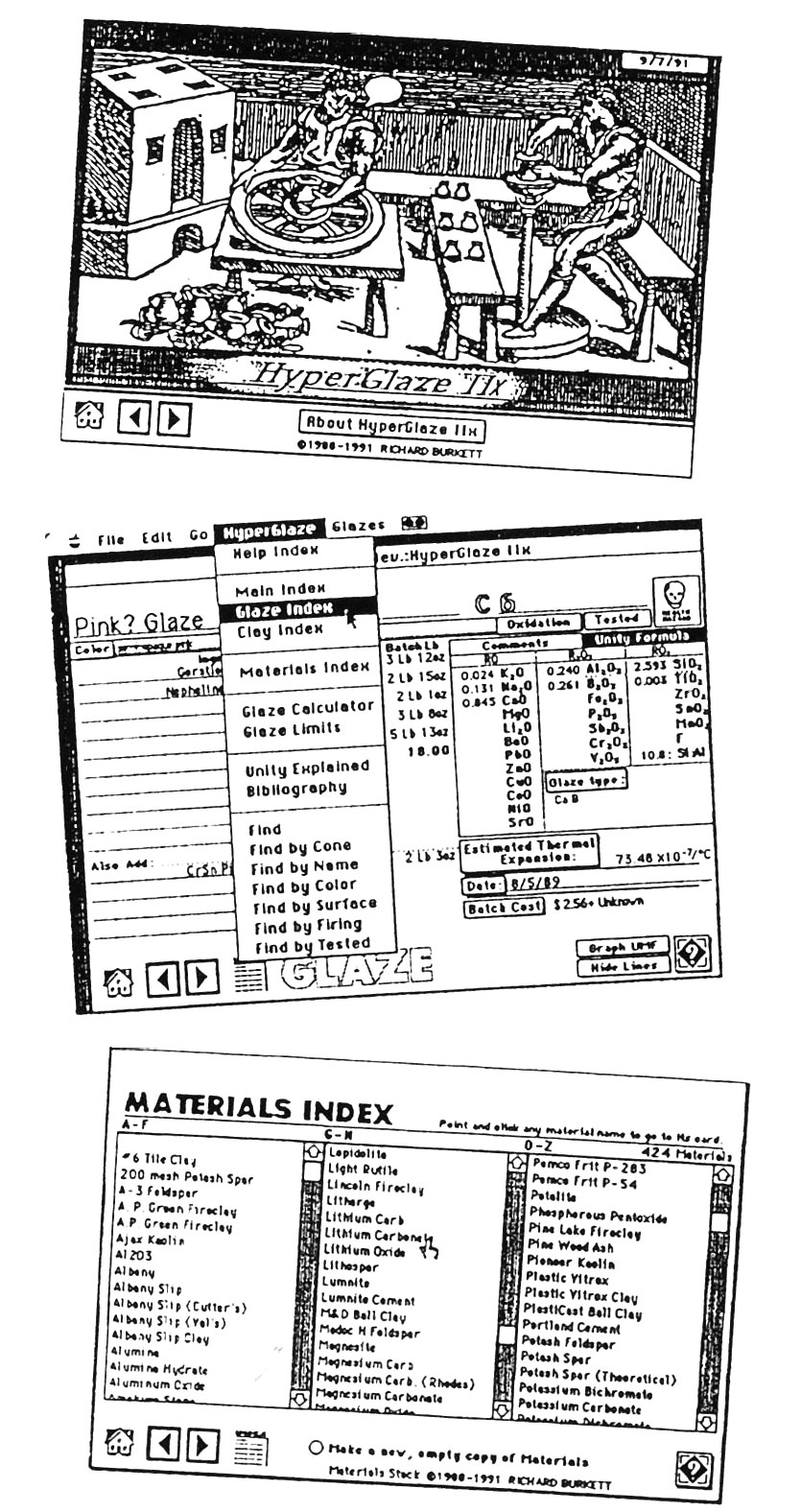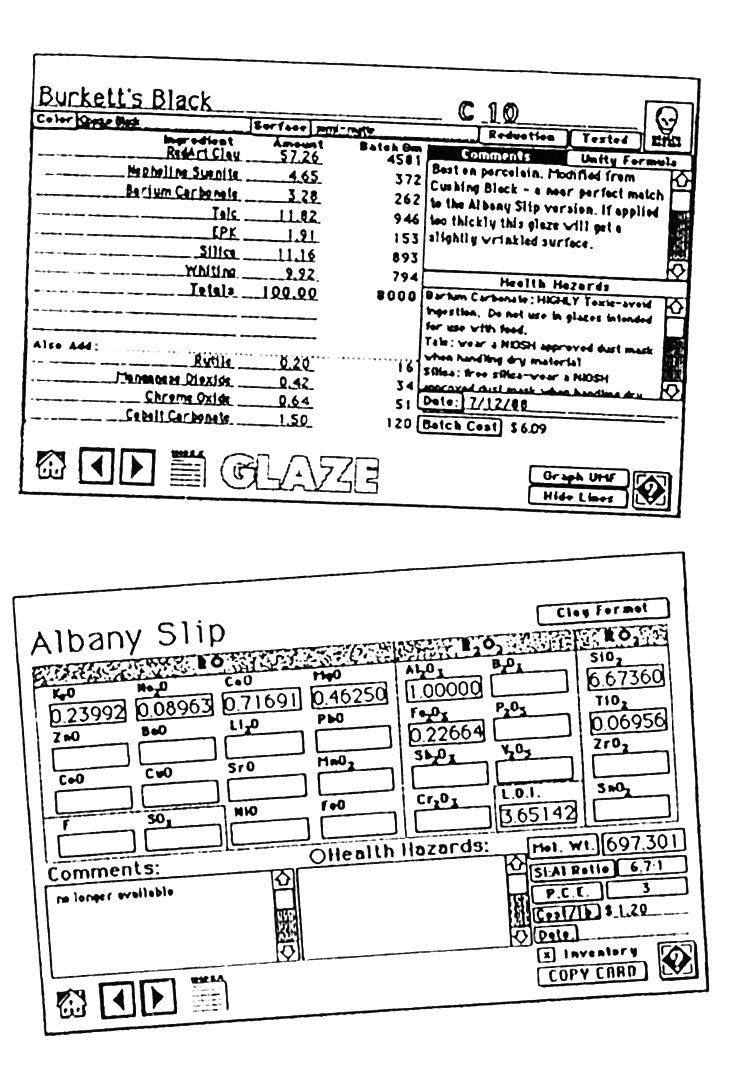Ceramics and Computers
Understanding the composition and formulation of ceramic materials is difficult and often baffling to many students of ceramics, and indeed to many potters. Books and magazines on ceramics contain a profusion of glaze recipes, and most of us keep our own battered notebooks full of recipes and analyses of materials collected from various sources. Searching for a recipe with a desired set of characteristics, such as a particular color, surface texture and firing temperature, is often a frustrating task. To make ingredient substitutions in a glaze, we must choose the lesser of two evils: either do complex, time-consuming calculations and a small amount of testing, or do a large number of tests based on our intuitive knowledge of glazes (along with a couple of good books on glazes) and hope we made a good guess.
Microcomputers offer a way to do this. The ability of computers to quickly retrieve and calculate information is an exciting possibility for the ceramic artist. But the computer's potential can be realized only if the computer program has an easy-to-use format with which potters are already familiar.

There is a great deal of questioning by the art world whenever artists make use of such seemingly alien pieces of equipment as the computer. Computers, many would argue, are in the realm of engineers and scientists who measure the world in numerical data. Artists deal with visual descriptions and translations of the same world but on a more personal and emotional level. Numerical analysis is a foreign way of thinking to most artists. But what if those thorny numerical problems could be eliminated or made more visual?
Ceramics is unique in the art world in its blend of the technical and artistic. Some technical knowledge and ability is always going to be necessary unless you have access to your own personal ceramics engineer or use only commercially available pre-mixed glazes and have your work fired for you. Most artists view such things as glaze formulation as an unnecessary annoyance. But what do you do when a material such as Albany slip is no longer available? Test dozens of new glazes? Just the task of locating a favorite recipe among notebooks stuffed with slips of paper can be a time-consuming hassle.
The creative use of clay and glazes by ceramics artists should be ultimately an intuitive gesture, but achieving that is usually the result of a lifetime of work in clay. Computers will never replace the magic of the accidental discovery or the rare beauty of the unexpected. Yet it is my hope to create software that makes the learning process-the process that allows one to work intuitively- faster and less painful.
The Computer as a Teaching Tool
As a teacher I feel that the computer's ability to perform calculations quickly can make less-used concepts more useful. These concepts can help ceramists understand how glazes work and how they can be altered to achieve one's personal vision. It is only the numerical presentation of these concepts that makes them a daunting obstacle for many artists.
For example, molecular formulas are a powerful tool in examining glaze recipes. While the actual ingredient-base recipes for a glaze may change as materials arrive from the mines, the molecular formulas for a glaze do not. Based on actual oxide amounts, they are stable over time. A unity formula written in the 1930s is still useful today, while a batch recipe will often fail due to changes in the materials. Unfortunately, the challenge of glaze calculation has inhibited use of molecular formulas. Computer software, however, can present concepts such as the molecular formula in a way that makes them understandable and useful.
Students already struggling with the ceramic process are often intimidated by the math of glaze calculation and its complexity. Yet, easy-to-use software can help them achieve greater control over their work. Large collections of glazes can be easily searched for specific glazes and further a student's interests. Glazes containing unavailable materials are quickly remade using materials at hand, with a high chance for success on the first try.
Using a computer for glaze calculation can also be an interactive learning process. Students can see how the addition of a material will change a recipe or how two identical glazes can be made using different materials. The dynamics of glaze formulation becomes apparent when you add or subtract oxides by "pointing and clicking" and instantly see the change in the thermal expansion of the glaze. The computer gives immediate feedback regarding the likely qualities of your glaze recipe. How does a particular oxide change the color obtained with a particular colorant? Finding it in textbooks often requires wading through pages of information. Computers can do this easily and quickly.
HyperGlaze Software for Ceramic Artists
I wrote a computer program called HyperGlaze initially to relieve myself of common frustrations and eliminate mistakes such as miscopying recipes and math errors in changing batch size. I chose to work with Macintosh computers because their format is easily seen. The user simply points to images on the screen with a hand-held "mouse" and then clicks the mouse button in a process known as "point and click." There is no need to memorize and type commands.
HyperGlaze works like an electronic stack of index cards containing recipes and other information. Each glaze recipe is displayed on its own screen or "card". You can look at cards in the digital "stack" in any order you want, sort them quickly, and always have an up-to-date index of all the recipes. The recipe format in HyperGlaze is familiar: a list of ingredients with their percentage and batch amounts. The colorants are listed below the base glaze recipe.
Given the nature of artists, I have tried to make HyperGlaze as visually useful as possible. The "user-friendly'' interface of the Macintosh computer, with its point-and-click approach, is fully utilized. Pulldown menus eliminate the need to memorize any type of code words or commands.
Typing has been eliminated as much as possible, except for the initial glaze recipe entry. One adds materials to the glaze recipe by simply pointing to and clicking on an item in a list. Recipes and information are moved around within HyperGlaze and saved for use with other programs without retyping.
Over time, HyperGlaze has evolved and has become more than a recipe file. Now it also does the following calculations for each card: percentage recipe, batch recipe (in pounds/ounces or grams and conversion between the two including colorant percentages), cost of the batch, estimated thermal expansion and unity molecular formula for the recipe. Unity molecular formulas can be converted easily and quickly to a batch recipe. One can make substantial notes about the glaze, its color and surface qualities, cone numbers, and firing type. Health hazards associated with materials in the glaze are displayed below the notes and comments. Health hazard information is added automatically to each recipe card when the glaze is calculated. The materials analyses and health hazards are kept in a separate database of materials that can be easily customized with favorite abbreviations for glaze ingredient names and the latest analyses. Finding recipes in the database is made by a search that looks for a number of attributes at once, such as color, cone, surface, etc.
The computer should not be situated in the ceramics studio because of dust and grit. All the recipes and information in HyperGlaze can be printed exactly as they appear on the computer screen and taken into the studio for use. One recipe can be printed at a time or several in any order desired. I use the printing feature as much as any other in HyperGlaze. I give my students a current list of class glazes with recipes of a size to make a bucketful. Glazes may also be saved as text files to use with any word processor. In this way, one can format different recipes or present a simplified recipe.
Much of HyperGlaze's usefulness as a learning tool comes from what can be done with the unity molecular glaze formula after it is calculated. The unity formula-a list of numbers and chemical symbols-is not easily comprehended, however. HyperGlaze displays the unity formula and the limit formula for a cone temperature in the form of a bar graph that is more visually informative. Information about each glaze's properties can be popped up on the screen when needed. Unity molecular formulas can be compared, personal limit formulas from groups of glazes calculated and unity formula charts of related glazes generated. These features add to the interpretive power of the software, making the computer a powerful learning tool. Information is quickly available when needed but does not intrude.

Future of HyperGlaze
The creation of HyperGlaze is an ongoing process, just as the future of computers in ceramics holds a number of possibilities. In the near future, the most intriguing of these is the ability to pick a color from a palette of choices and to have the computer give specific information on how to make the glaze or even formulate a glaze for you. To achieve this, however, will require compiling information not currently available in one place in a convenient form. Many ceramists, after years of working with clay, can take a quick look at a glaze recipe and make a good guess as to its character and how colorants will react. This is the type of expert knowledge that should be condensed and made available through software. Such expert systems, similar to those used for medical diagnosis, could dispense specific and useful information on glazes and provide a powerful diagnostic tool for the ceramist. To reach this goal, however, a group effort will be required to gather and organize the large amounts of information necessary to make computer manipulation of glazes a more visual process.
This is the next step.

